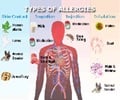Aged cheeses may sometimes cause allergy-like reactions in many people. However, a new study identifies bacteria that may reduce those unpleasant side effects.

‘Aged cheeses may sometimes cause allergy-like reactions in many people. However, looking closely at the microbial communities that form in cheese rinds could pave the way for developing improved cheese production techniques that could cut down on the compound that causes those unpleasant side effects.’
Read More..




The answer to alleviating the unpleasant reactions that result from eating ripened cheeses could lie in the bacteria that populate the cheese's rind, said Stephan Schmitz-Esser, associate professor of animal science. Schmitz-Esser led a new study that looks closely at the microbial communities that develop in cheese rinds, and the research could pave the way to improved cheese production techniques that cut down on the compound that causes those reactions.Read More..
Many hard cheese varieties, such as Comte and Gruyere, require months to ripen to obtain the desired flavor and aroma. As the cheeses ripen, a biofilm of bacteria and fungi develops on the surface of the cheese. These microbial communities, which form naturally and are not inoculated by cheese producers, play an essential role in the ripening process and can protect the cheese from harmful pathogens, Schmitz-Esser said.
"We still know surprisingly little about these microbial communities that grow on the cheese rind," he said. "We know that they work, but we don't know a lot beyond that."
These microbes produce histamine, a compound involved in local immune responses, as a byproduct of fermentation, he said. Foods that contain high levels of histamine can cause rashes and other symptoms associated with allergic reactions in roughly 1 percent of humans.
So Schmitz-Esser and his collaborators set out to answer some of the questions cheese producers have about those microbes. The researchers sampled cheese rinds originating in Austria and isolated the bacteria strains they contain. They identified a particular bacterial genus, called Brevibacterium, and sequenced the genomes of three different species. That data allowed them to identify pathways in the bacterial genomes that are likely to govern the degradation of histamine. Finally, the researchers grew the bacteria in an experimental medium and demonstrated their ability to break down histamine.
Advertisement
"Ultimately, this could allow us to intentionally use such strains that have the ability to break down histamine," he said. "These bacteria would support the ripening process and, at the same time, reduce histamine production."
Advertisement
Source-Eurekalert













